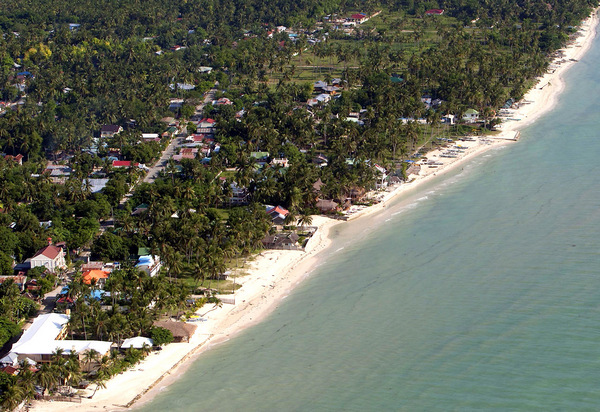‘REMOVE ILLEGAL STRUCTURES IN STA. FE’

An aerial view of the Sta. Fe shoreline in northern Cebu shows the pristine waters and white sand of this tourism destination in this 2011 file photo.
Court order covers 21 houses, kiosks and portions of resorts that encroach 20-meter easement zone
Structures that obstruct the beachline of Santa Fe town on Bantayan Island, in northern Cebu will have to go.
An environmental court in Mandaue City, Cebu has ordered the Department of Environment and Natural Resources in Central Visayas (DENR-7) to tear down at least 21 houses, kiosks and parts of beach resorts in the municipality.
The Mandaue Regional Trial Court (RTC) Branch 28 ruled that the structures reportedly violated Presidential Decree 1067 or the Water Code of the Philippines which prohibits structures on the easement zone — the area reached by the highest tide going 20 meters inland.
This was already the second demolition order issued by the court.
In 2010, the court also directed the demolition of structures near the shorelines in Sta. Fe such as sea walls and kiosks of resorts.
An ocular inspection was later conducted to determine if there were other structures in the easement zone.
Apparently, more violations were discovered during the inspection, prompting the court to issue another order.
Stephanie Chan, information officer of DENR-7, said the department’s legal office already received the Writ of Mandamus issued by the court.
“We already have it but we cannot release any statement or act on it yet unless our Community Environment and Natural Resources Office (Cenro) meets with our regional director,” she said in an interview on Friday.
Chan said DENR-7 Director Gilbert Gonzales was set to meet with Cenro officials and the DENR Legal Office on Tuesday to discuss on how to implement the court order.
The demolition capped a legal battle waged by some Bantayan residents and environment advocates led by lawyer Antonio Oposa, who filed a petition for patrimonial malpractice, mandamus and damages.
Cebu Daily News tried but failed to reach Oposa through the phone on Friday.
William Medici, spokesperson of the Santa Fe Tourism Enterprise Association (Safetea), said they would ask the court to reconsider its ruling and to forego any demolition that would affect some of its member-resorts.
The Safetea is composed of locals who have businesses in the town including market vendors, hotels, restaurants and resort owners.
“We will be submitting a position paper in court to explain our side,” he told Cebu Daily News over the phone.
Medici said the owners of the structures, especially the resorts, are aware of the 20-meter easement policy.
When the structures were built, he said they never encroached the easement zone.
However, continuous soil erosion in the coastline of Santa Fe made it appear that the structures fall within the easement zone.
“When the water level increased, it seemed that the shoreline also moved. So now, the structures appear to be closer to the sea,” Medici explained.
“But before, that is not the case. They did not fall within the easement zone,” she added.
Medici said owners of the structures have already met with Cenro officials to explain their side.
“It would be unfair for the court to say that we violated the easement rule because soil erosion has taken place. The structures have been there for so long and they did not violate the easement rule when they were constructed years ago,” he said. Medici believed the soil erosion and adjustment in the shoreline was caused by the construction of the Santa Fe Port.
A study conducted by a university that was released in 2013, he said, showed that the port has caused soil erosion in the seashores of Santa Fe, one of three towns on Bantayan Island. The two others are Bantayan and Madridejos.
Presidential Decree 1067 or the Water Code of the Philippines prohibits building structures within the easement zone of a seashore, river or stream.
The zone, the law states, is subject to the easement of public use for recreation, navigation, and fishing, among others. The distance is 20 meters for agricultural areas (as in the case of Sta. Fe), three meters for urban areas, and 40 meters for forest areas.
Bantayan Island, where Sta. Fe lies, is a popular tourist destination due to its white sand beaches.
The island is covered by two special laws: Presidential Proclamation No. 2151 of 1981 declaring the island a protected area and Presidential Proclamation No. 1234 declaring Tañon Strait a protected seascape.
Disclaimer: The comments uploaded on this site do not necessarily represent or reflect the views of management and owner of Cebudailynews. We reserve the right to exclude comments that we deem to be inconsistent with our editorial standards.




